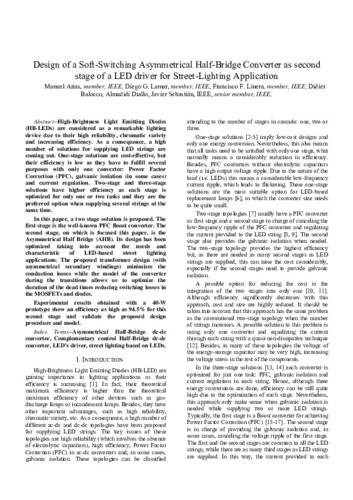Design of a Soft-Switching Asymmetrical Half-Bridge Converter as Second stage of a LED Driver for Street-Lighting Application
Fecha de publicación:
Versión del editor:
Citación:
Descripción física:
Resumen:
High-brightness LEDs are considered remarkable lighting devices due to their high reliability, chromatic variety, and increasing efficiency. As a result, a high number of solutions for supplying LED strings are emerging. One-stage solutions are cost-effective, but their efficiency is low because they have to fulfill several purposes with only one converter: power factor correction (PFC), galvanic isolation (in some cases), and current regulation. Two-stage and three-stage solutions have higher efficiency because each stage is optimized for only one or two tasks and they are the preferred options when supplying several strings at the same time. In this paper, a two-stage solution is proposed. The first stage is the well-known PFC boost converter. The second stage, on which this paper is focused, is the asymmetrical half bridge (AHB). Its design has been optimized based on the needs and characteristics of LED-based street lighting applications. The proposed transformer design (with asymmetrical secondary windings) minimizes the conduction losses while the model of the converter during the dead times optimizes their duration, reducing switching losses in the MOSFETs and diodes. Experimental results obtained with a 40-W prototype show an efficiency as high as 94.5% for this second stage and validate the proposed design procedure and model
High-brightness LEDs are considered remarkable lighting devices due to their high reliability, chromatic variety, and increasing efficiency. As a result, a high number of solutions for supplying LED strings are emerging. One-stage solutions are cost-effective, but their efficiency is low because they have to fulfill several purposes with only one converter: power factor correction (PFC), galvanic isolation (in some cases), and current regulation. Two-stage and three-stage solutions have higher efficiency because each stage is optimized for only one or two tasks and they are the preferred options when supplying several strings at the same time. In this paper, a two-stage solution is proposed. The first stage is the well-known PFC boost converter. The second stage, on which this paper is focused, is the asymmetrical half bridge (AHB). Its design has been optimized based on the needs and characteristics of LED-based street lighting applications. The proposed transformer design (with asymmetrical secondary windings) minimizes the conduction losses while the model of the converter during the dead times optimizes their duration, reducing switching losses in the MOSFETs and diodes. Experimental results obtained with a 40-W prototype show an efficiency as high as 94.5% for this second stage and validate the proposed design procedure and model
ISSN:
Patrocinado por:
Trabajo financiado por AEG Power, Soluciones B.V. (FUO-EM-002-10) y por el Gobierno español (MICINN-10- CSD2009-00046)
Colecciones
Ficheros en el ítem




